Adolph John Paschang
| Adolph John Paschang | |
|---|---|
| Born |
16 April 1895 Martinsburg, Missouri |
| Died |
3 February 1968 Hong Kong |
| Resting place | O71G, Ossarium G, St Michael's Catholic Cemetery, Happy Valley, Hong Kong |
| Nationality | American |
| Alma mater |
Campion High School, Wisconsin; Kenrick Seminary, St. Louis |
| Occupation | Missionary, bishop, priest, relief worker, educator |
| Years active | 1923—1968 |
| Home town | Martinsburg, Audrain County, Missouri |
| Title | Bishop |
| Predecessor | Bishop James Edward Walsh |
| Successor | Bishop Li Pan shi (李盤石) (consecrated in 1981) |
| Religion | Roman Catholic |

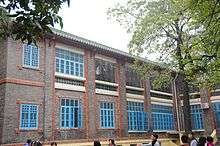
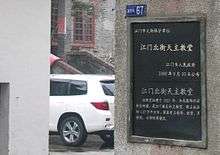
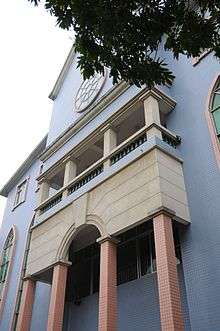
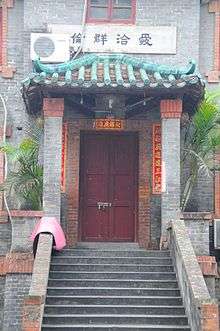
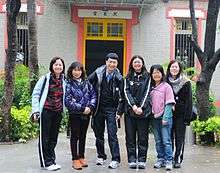
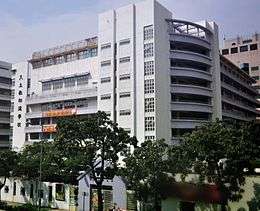
Bishop Adolph John Paschang (Chinese: 柏增主教, April 16, 1895 – February 3, 1968) was an American Maryknoll Catholic bishop,[1] missionary, relief worker and educator working in southern part of China in the early 20th century.
Early life
Fr Adolph J. Paschang was born in Martinsburg, Audrain County, Missouri.[1] He grew up on a farm there, studied at Campion College of the Sacred Heart (1916) (now Campion High School),[2] then at St. Louis University High School in St. Louis,[3] then at Kenrick Seminary in St. Louis.[4] He joined the newly founded Catholic Foreign Mission Society of America, commonly known as the Maryknoll Fathers and Brothers, and was ordained a priest on 21 May 1921.[5] After being ordained a priest, Paschang was immediately sent off to Kongmoon (now known as Jiangmen) China.[6]
Ministries
Fr Adolph J. Paschang preached and worked in southern China, covering Gaozhou, previously known as Kochow (Fr Paschang once worked in the Sacred Heart School in Gaozhou, Maoming, the second school ever founded by the Maryknollers in China, by Fr Bernard F. Meyer with inauguration held on 5 October 1923. and first graduation on 1926 August 30 [7][8]), Yangjiang (previously known as Yeungkong), Jiaying (previously known as Kaying) Taishan (previously known as Toishan) and Jiangmen. He was appointed Vicar Apostolic of Kongmoon on 17 June 1937 (consecrated Bishop on 30 November 1937[9]), and later appointed Bishop of the Catholic Diocese of Jiangmen (previously known as Kongmoon) on 11 April 1946, lived through the Japanese Invasion and Occupation of China in the Second World War.[7]
Second World War
Japan invaded China in phases in the 1930s, gradually taking southern China towards the end of the decade. Until the attack on Pearl Harbor of 1941, Paschang and his diocese were relatively undisturbed by Japanese forces, given that he possessed American citizenship.
In February 1941, Fr Paschang received a pass from the Japanese occupation forces to visit Hong Kong. The real purpose for his move was to leapfrog over into the unoccupied areas of his Diocese of Jiangmen in order to visit the priests and Sisters. During his stay in Hong Kong, Fr Joe Sweeney from the Gate of Heaven Leprosarium in Ngaimen arrived, and recounted the adventurous journey he had just made: the motor launch carrying Fr Big Joe and other passengers had been attacked by a Japanese patrol boat towards evening, but they escaped capture as darkness descended and allowed them to slip unsighted past the patrol boat. Bishop Paschang would have to take the same route and the same risks on his return visitations.[10] While Bishop Paschang was in Hong Kong, he performed the ordinations at the Dominican Rosary Hill chapel, in the absence of Bishop Enrico Valtorta.[10]
In May 1946, Bishop Paschang arrived at Stanley for a conference with more than a dozen Ordinaries of South China, including the four Ordinaries of Maryknoll. He arrived with a van dyke beard – only his Episcopal rank saved him from the customary Stanley practice of removing beards by force.[10]
Early years of Communist Rule
After the liberation of Mainland China he chose to stay behind. He was captured and tortured[11] by the Chinese Communist authorities.
- On 5 December 1951, Paschang was forced to contact Stanley House in Hong Kong on three times to relay information that the Chinese Communists were demanding US$22,000.[12]
- On 7 December 1951, the ransom price was reduced to US$6,000, but nothing was paid.[13][14]
- On 19 December 1952, similar news was reported in The New York Times, “December 18 An official Roman Catholic spokesman said today that a 56-year-old Bishop, the Most Rev. Adolph Paschang of Kongmoon (now called Jiangmen), Kwangtung Province (now named Guangdong Province), had been beaten again there following the church's refusal to pay "ransom money" to the Chinese Communists as a means of saving him from the violence of the intensified "land reform" in that southeastern coastal province.”.[15] *Bishop Paschang was subsequently severely tortured and broken as a person.[16]
Release by the Communist into Hong Kong
Fr. William Downs in his Maryknoll Hong Kong Chronicle recorded on 9 June 1952, “Bishop Paschang, after (being) very badly treated”, “was finally expelled from China”. Bishop Paschang was marched “from his mission at Pakkai” (now called Beijie, where the Immaculate Heart of Mary Cathedral, i.e. cathedral of the Diocese of Jiangmen, was located), “placed him on a junk and sailed off – he did not know his destination and the thought of Father Sandy Cairns’ unhappy ending at the hands of the Japanese must have crossed his mind".[6]
- On 6 June 1952 Friday night, Paschang crossed the Chinese border into Portuguese Macao.[17]
- On 9 June 1952 Mondayand finally reached Hong Kong. Lots of reporters were waiting anxiously for him at the Hong Kong Pier. Upon arrival, Bishop Adolph Paschang recalled that he had been made to kneel on broken bricks in the winter of 1951, in a third-degree procedure,[18] but he had no hatred at all. After a long interview, Fr Paschang could finally return to the Stanley House for a very late dinner.
Later life
After his expulsion by the Communist Chinese government, Bishop Paschang stayed in the Maryknoll Stanley House,[19] headquarters of the Maryknoll Fathers and Brothers in Hong Kong, visited the States briefly but again returned to Hong Kong out of his love of the Chinese people.[5]
- In March 1957, Fr Paschang suffered a severe cerebral thrombosis, and was hospitalized. He was thereafter no longer able to walk. The Canossian Sisters’ St. Francis Hospital in Wanchai became his home for the best part of a year.[6]
- In October 1957, Fr Paschang insisted on leaving hospital, and returned to the Maryknoll Stanley House. Arrangements were made there after a meeting with the visiting Superior General, Father John Comber, and a storeroom on the ground floor next to the kitchen was transformed into a “suite” for him. He was in the tender, if non-professional, care of faithful houseboy Ah Fung.[6]
- In May 1958, Fr Paschang was finally constrained to use a wheelchair.[6] Despite his delibilities, he continued to attend mass regularly and assist in church services as far as his ailing body allowed.
- On 3 February 1968, Paschang died in St. Paul's Hospital in Causeway Bay, Hong Kong.[5]
Memorial
In memory of Paschang, when a new primary school was founded by the Maryknollers in Ngau Tau Kok, Kowloon in 1969, it was named Bishop Paschang Memorial School, which is now known as Bishop Paschang Catholic School.[20]
In the late 1990s, the Hong Kong SAR Government planned to re-develop the Lower Ngau Tau Kok Estate, where Bishop Paschang Memorial School was situated. In 1997, the headmaster at that time, Leung Kwok Hung, applied for a new school premises from the government[21] and was given a new school building in a "school village" in Kowloon Bay. AM section of Bishop Paschang Memorial School moved to the new campus in Kowloon Bay in 2002. The new school was named Bishop Paschang Catholic School.[22]
The school building of Bishop Paschang Memorial School was finally handed back to the government of Hong Kong in 2008, in line with the plan of demolishing the then remaining portion of the Lower Ngau Tau Kok Estate. The remaining classes of the PM section of Bishop Paschang Memorial School were relocated to Bishop Paschang Catholic School in Kowloon Bay as well.[23]
See also
References
- 1 2 "Bishop Adolph John Paschang, M.M.". Catholic-Hierarchy.org. David M. Cheney. Retrieved 2015-01-21.
- ↑ Staber (S.J.), Sylvester J. (1979). "Short History Of Campion High School — Prairie Du Chien, Wisconsin". Retrieved 2011-05-01.
- ↑ "Biographies: Bishop Adolph J. Paschang, MM". Maryknoll Mission Archives. Retrieved 2014-08-17.
- ↑ "Newsletter of the St. James Parish Family" (PDF). Potosi, Missouri: St. James Catholic Church. 2009-06-19.
- 1 2 3 Bishop Paschang Catholic School 40th anniversary memorial publication. Hong Kong: Bishop Paschang Catholic School. 2009.
- 1 2 3 4 5 Smith, Jim; Downs, William (1978). Maryknoll Hong Kong Chronicle 1918–1975 (Chronicle). Catholic Foreign Mission Society of America. (available from the University of Hong Kong Library, but for in-library reading only)
- 1 2 (Taiwanese Mandarin) Barry, Peter (1977). 瑪利諾會在華傳教簡史 (Masters thesis). 台灣大學歷史學研究所.
- ↑ "Fr. Paschang and graduating class at Gaozhou, Maoming, China, 1926". Retrieved 2011-05-01.
- ↑ "Consecration of Bishop Paschang, Hong Kong, China, November 30, 1937". Retrieved 2011-05-03.
- 1 2 3 Smith, James (1980). The Maryknoll Mission, Hong Kong 1941–1946 (book). Dept. of History, University of Hong Kong.
- ↑ Pownall Reeves, John (2014). The Lone Flag: Memoir of the British Consul in Macau during World War II. Hong Kong University Press. p. 190. ISBN 978-988-8208-32-6.
- ↑ "Bishop Reports Torture; Missionary Says Chinese Reds Ask $22,000—Payment Ruled Out". The New York Times. 1951-12-06. p. 6. Retrieved 2011-06-01.
- ↑ "Bishop Beaten, $6000 Demanded" (PDF). Long Beach Press-Telegram (Calif.). 1951-12-07. Retrieved 2011-05-03.
- ↑ Tiedemann, R.G. (2009). Reference guide to Christian missionary societies in China: from the 16th to the 20th century. M. E. Sharpe. ISBN 978-0-7656-4001-7. Retrieved 2011-05-03.
- ↑ Lieberman, Henry R. (1951-12-19). "Chinese Reds Beat U.S. Bishop 2nd Time...". The New York Times. p. 5. Retrieved 2011-06-01.
- ↑ Leung, Beatrice; Liu, William T (2004). The Chinese Catholic Church in Conflict: 1949–2001. Universal-Publishers. ISBN 1-58112-514-3. Retrieved 2011-05-03.
- ↑ "Bishop Paschang Free; American Roman Catholic Gets Out of Communist China". The New York Times. 1952-06-08. Retrieved 2011-06-01.
- ↑ "Reds Beat Him To Get Money, Prelate Says". The New York Times. 1952-06-10. p. 5. Retrieved 2011-06-01.
- ↑ "The Stanley House (A Short History)". Chinahands. The Maryknoll Fathers and Brothers in China (official blog). 2010-07-28. Retrieved 2011-03-28.
- ↑ Bishop Paschang Memorial School 25th anniversary memorial publication. Hong Kong: Bishop Paschang Memorial School. 1994.
- ↑ Bishop Paschang Memorial School 39th anniversary memorial publication. Hong Kong: Bishop Paschang Memorial School. 2008.
- ↑ "Bishop Paschang Catholic School website". Retrieved 2011-03-27.
- ↑ (traditional Chinese (HK)) 回憶.情 在牛頭角下邨的共同歲月. 香港聖公會福利協會. 2009. ISBN 978-962-7967-28-6.
External links
- UCA news
- Fr. Paschang with Latin students at Yangjiang, China, 1924 from USC digital library Website
- Children enjoying firecrackers at Jiangmen, China, 1947 from USC digital library Website
- Maryknoll priests at Dongzhen, China, 1922 from USC digital library Website
- Sacred Heart Hospital staff, Toishan, China, ca. 1949 from USC digital library Website
- Maryknoll Priests and Sisters at Hong Kong, China, ca. 1925 from USC digital library Website
- Bp. Fourquet at installation of Fr. Paschang at Jiangmen, China from USC digital library Website
- Bishop Paschang Catholic School official website
| Catholic Church titles | ||
|---|---|---|
| Preceded by James Edward Walsh |
Bishop of Jiangmen 1937—1968 |
Succeeded by Li Pan Shi (consecrated in 1981) |